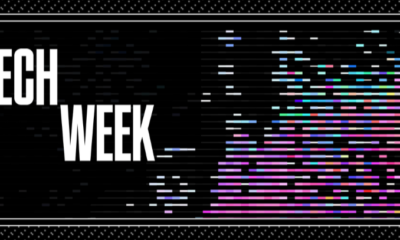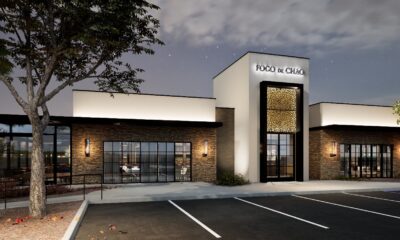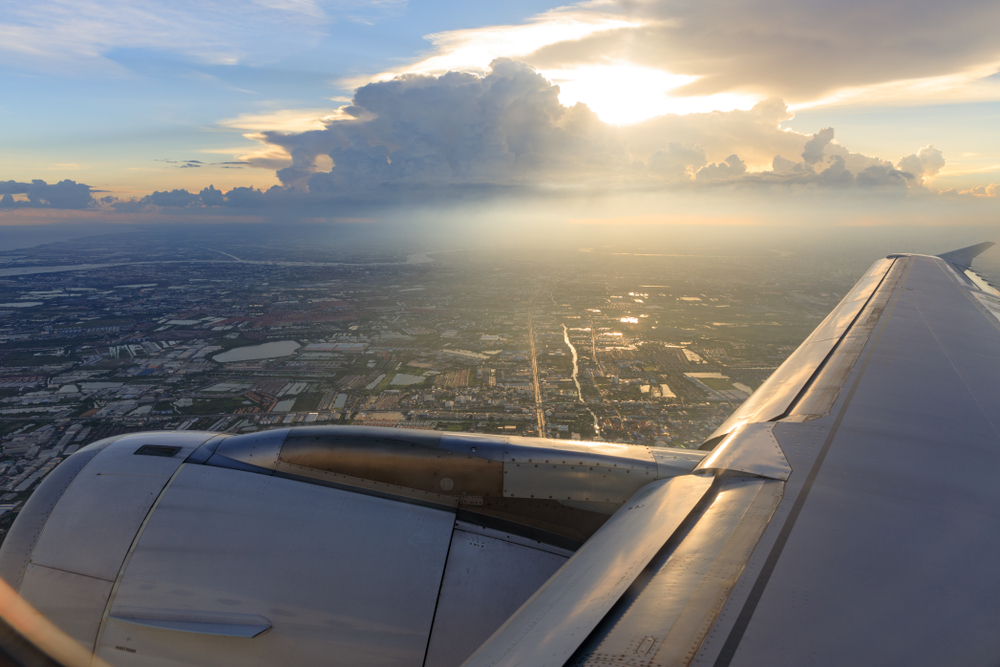Transportation
In Year of Pandemic, Ontario International Airport Saw Surge in Cargo; Passenger Volume Cut in Half
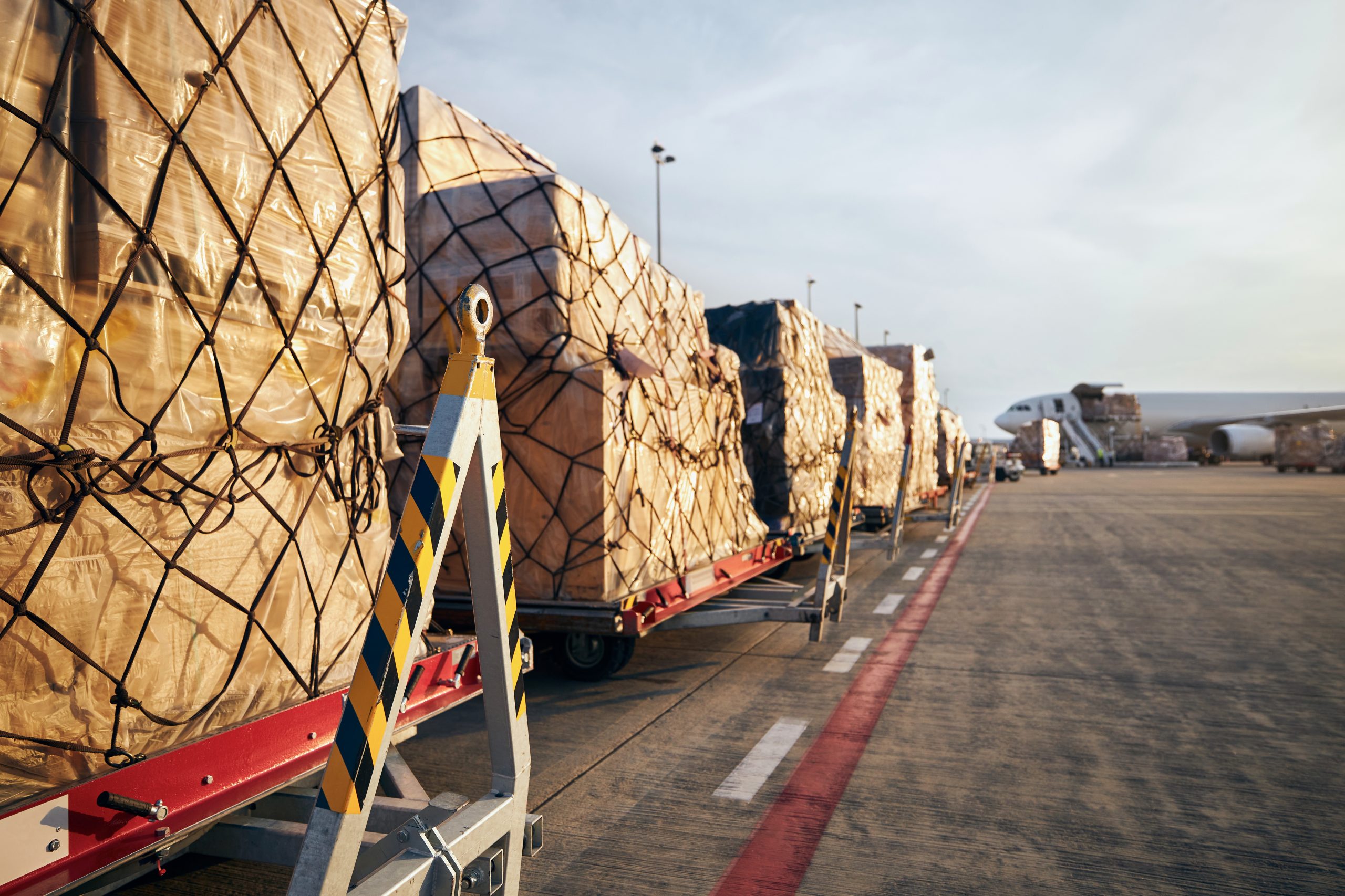
Ontario International Airport freight volume rose 18% in 2020
Despite the staggering impact of the COVID-19 pandemic on global aviation, Ontario International Airport (ONT) looks forward to maintaining its position as a leading cargo hub and welcoming back air travelers in greater numbers in 2021.
Two weeks into the New Year, airport officials announced final statistics for 2020, with cargo volumes growing more than 18% year-over-year, while the number of passengers who traveled through ONT was down more than 50%.
For the year, ONT processed nearly 900,000 tons of commercial freight, 18.2% higher than the previous year. Freight shipments increased by double-digits in 10 months in 2020 and by more than 20% in six months. Mail shipments increased almost 17% to more than 25,000 tons last year.
In December, freight tonnage totaled more than 93,000 tons, 6% higher than the same month in 2019 while shipments of mail grew 340% to more than 3,600 tons.
| Air cargo (tonnage) | December 2020 | December 2019 | Change | YTD 2020 | YTD 2019 | Change |
| Freight | 93,622 | 88,228 | 6.11% | 898,188 | 760,045 | 18.2% |
| 3,662 | 832 | 340.41% | 25,635 | 21,948 | 16.8% | |
| Total | 97,284 | 89,060 | 9.23% | 923,823 | 781,993 | 18.1% |
“Ontario solidified its position as a leading air cargo hub in 2020,” said Mark Thorpe, chief executive officer of the Ontario International Airport Authority. “Working closely with our freight partners, we not only withstood the surge in e-commerce shipments early in the year, we ramped up quickly to manage double-digit increases in commercial freight volume as Californians hunkered down at home and shopped online for vital household supplies.”
As for passenger travel, more than 2.5 million air travelers moved through ONT last year, roughly half as many as 2019. Domestic passengers totaled more than 2.4 million while the number of international travelers exceeded 95,000, decreases of 53% and 68%, respectively. In December, as public health officials urged Americans to avoid non-essential travel, passenger volume declined nearly 63% to 190,000. Domestic travelers numbered more than 182,000 and international passengers 7,000, decreases of 62% and 73%, respectively.
Even with the decline, ONT fared significantly better than most airports in California and across the world. Recent projections show air passenger volumes globally fell at least 60% in 2020 as a result of the pandemic.
Passenger Totals December 2020 December 2019 Change YTD 2020 YTD 2019 Change Domestic 182,779 485,086 -62.32% 2,443,042 5,279,722 -53.7% International 7,755 29,703 -73.89% 95,440 304,010 -68.6% Total 190,534 514,789 -62.99% 2,538,482 5,583,732 -54.5%
“Despite the challenging passenger numbers for 2020, several airline partners restarted service to popular destinations in the second half of the year and announced additional routes for the first half of 2021,” Thorpe said. “We stand ready to support airlines operating at Ontario and we are eager to welcome back our customers as coronavirus vaccines become more widely available and travel routines return to more normal levels.”
Transportation
Brightline West Breaks Ground on America’s First High-Speed Rail Project Connecting Las Vegas to Rancho Cucamonga
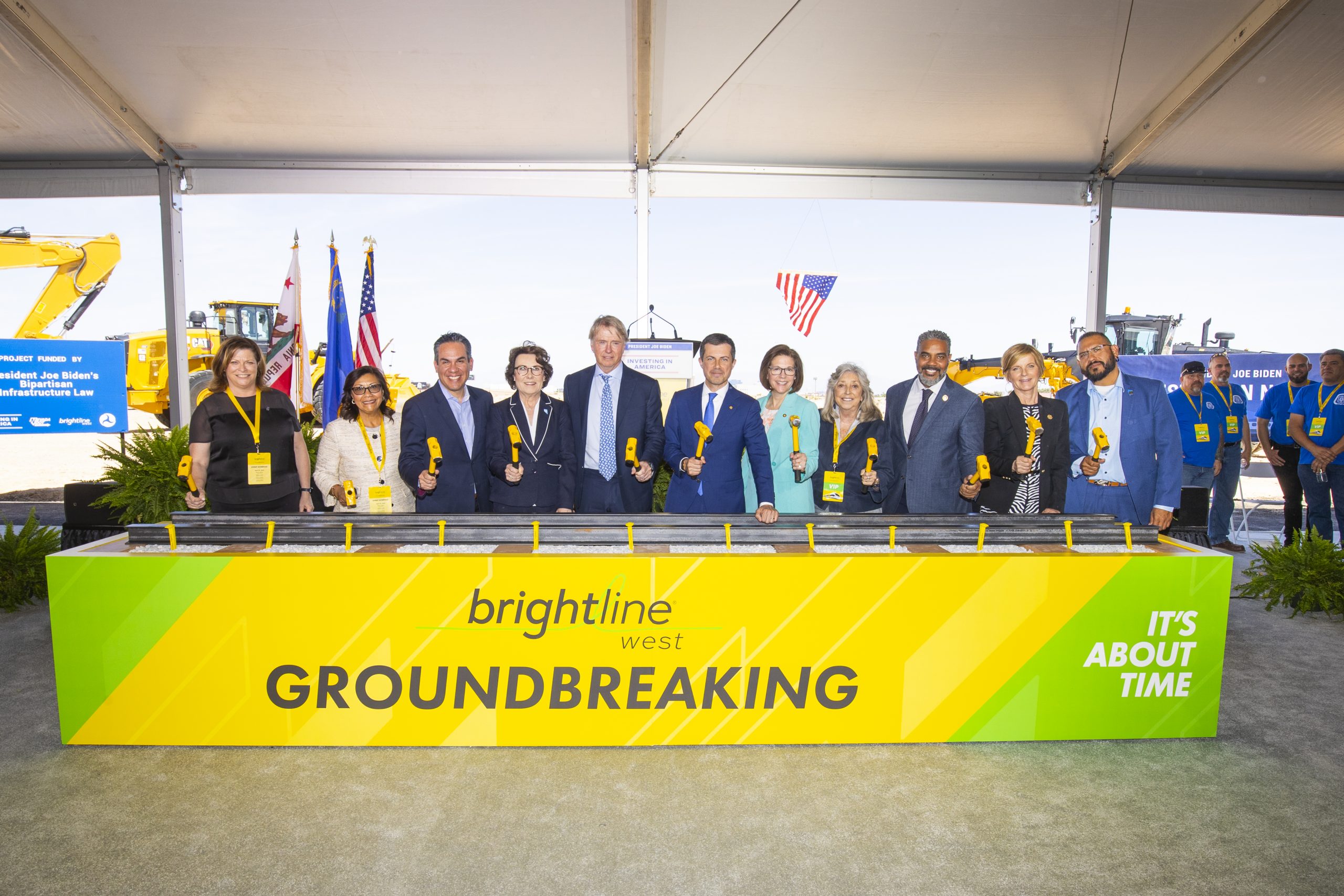
Officials Hammer the First Spike Commemorating the Groundbreaking for Brightline West
Today, Brightline West officially broke ground on the nation’s first true high-speed rail system which will connect Las Vegas to Southern California. The 218-mile system will be constructed in the middle of the I-15 and is based on Brightline’s vision to connect city pairs that are too short to fly and too far to drive. Hailed as the greenest form of transportation in the world, Brightline West will run zero emission, fully electric trains capable of speeds of 200 miles per hour. Brightline West is a watershed project for high-speed rail in America and will establish the foundation for the creation of a new industry and supply chain. The project was recently awarded $3 billion in funding from President Biden’s Bipartisan Infrastructure Bill. The rest of the project will be privately funded and has received a total allocation of $3.5 billion in private activity bonds from USDOT.
The groundbreaking included remarks from U.S. Transportation Secretary Pete Buttigieg, Brightline Founder Wes Edens, Nevada Gov. Joe Lombardo, Sen. Catherine Cortez, Sen. Jacky Rosen, California Rep. Pete Aguilar, Senior Advisor to President Biden Steve Benjamin and Vince Saavedra of the Southern Nevada Building Trades. In addition, Nevada Reps. Dina Titus, Susie Lee and Steve Horsford and California Rep. Norma Torres joined the celebration. More than 600 people, including union representatives, project supporters and other state and local officials from California and Nevada, attended the event.
“People have been dreaming of high-speed rail in America for decades – and now, with billions of dollars of support made possible by President Biden’s historic infrastructure law, it’s finally happening,” said Secretary Buttigieg. “Partnering with state leaders and Brightline West, we’re writing a new chapter in our country’s transportation story that includes thousands of union jobs, new connections to better economic opportunity, less congestion on the roads, and less pollution in the air.”
“This is a historic project and a proud moment where we break ground on America’s first high-speed rail system and lay the foundation for a new industry,” said Wes Edens, Brightline founder. “Today is long overdue, but the blueprint we’ve created with Brightline will allow us to repeat this model in other city pairs around the country.”
CONSTRUCTION OF BRIGHTLINE WEST
Brightline West’s rail system will span 218 miles and reach speeds of 200 mph. The route, which has full environmental clearance, will run within the median of the I-15 highway with zero grade crossings. The system will have stops in Las Vegas, Nev., as well as Victor Valley, Hesperia and Rancho Cucamonga, Calif.
The privately led infrastructure project is one of the largest in the nation and will be constructed and operated by union labor. It will use 700,000 concrete rail ties, 2.2 million tons of ballast, and 63,000 tons of 100% American steel rail during construction. Upon completion, it will include 322 miles of overhead lines to power the trains and will include 3.4 million square feet of retaining walls. The project covers more than 160 structures including viaducts and bridges. Brightline West will be fully Buy America Compliant.
STATIONS AND FACILITIES
Brightline West will connect Southern California and Las Vegas in two hours or almost half the time as driving. The Las Vegas Station will be located near the iconic Las Vegas Strip, on a 110-acre property north of Blue Diamond Road between I-15 and Las Vegas Boulevard. The site provides convenient access to the Harry Reid International Airport, the Las Vegas Convention Center and the Raiders’ Allegiant Stadium. The station is approximately 80,000 square feet plus parking.
The Victor Valley Station in Apple Valley will be located on a 300-acre parcel southeast of Dale Evans Parkway and the I-15 interchange. The station is intended to offer a future connection to the High Desert Corridor and California High Speed Rail. The Victor Valley Station is approximately 20,000 square feet plus parking.
The Rancho Cucamonga Station will be located on a 5-acre property at the northwest corner of Milliken Avenue and Azusa Court near Ontario International Airport. The station will be co-located with existing multi-modal transportation options including California Metrolink, for seamless connectivity to Downtown Los Angeles and other locations in Los Angeles, Orange, San Bernardino and Riverside Counties. The Rancho Cucamonga Station is approximately 80,000 square feet plus parking.
The Hesperia Station will be located within the I-15 median at the I-15/Joshua Street interchange and will function primarily as a local rail service for residents in the High Desert on select southbound morning and northbound evening weekday trains.
The Vehicle Maintenance Facility (VMF) is a 200,000-square-foot building located on 238 acres in Sloan, Nev., and will be the base for daily maintenance and staging of trains. This site will also serve as one of two hubs for the maintenance of way operations and the operations control center. More than 100 permanent employees will report on a daily basis once operations begin and will serve as train crews, corridor maintenance crews, or operations control center teammates. A second maintenance of way facility will be located adjacent to the Apple Valley station.
MARKET
The Las Vegas and Southern California travel market is one of the nation’s most attractive corridors with over 50 million trips between the region each year. Additionally, Las Vegas continues to attract visitors from around the world, with 4.7 million international travelers flying into the destination. The city dubs itself on being the world’s No. 1 meeting destination, welcoming nearly 6 million people to the Las Vegas Convention Center last year.
In California, approximately 17 million Southern California residents are within 25 miles of the Brightline West station sites. Studies show that one out of every three visits to Las Vegas come from Southern California.
ECONOMIC & ENVIRONMENTAL BENEFITS
Brightline West’s $12 billion infrastructure investment will create over $10 billion in economic impact for Nevada and California and will generate more than 35,000 jobs, including 10,000 direct union construction roles and 1,000 permanent operations and maintenance positions. The investment also includes over $800 million in improvements to the I-15 corridor and involves agreements with several unions for skilled labor. The project supports Nevada and California’s climate goals by offering a no-emission mobility option that reduces greenhouse gasses by over 400,000 tons of CO2 annually – reducing vehicle miles traveled by more than 700 million each year and the equivalent of 16,000 short-haul flights. The company will also construct three wildlife overpasses, in partnership with the California Department of Fish and Wildlife and Caltrans for the safe passage of native species, primarily the bighorn sheep.
BRIGHTLINE FLORIDA
Brightline’s first rail system in Florida connecting Miami to Orlando began initial service between its South Florida stations in 2018. In September 2023, Brightline’s Orlando station opened at Orlando International Airport, connecting South Florida to Central Florida. The company has plans to expand its system with future stops in Tampa, Florida’s Space Coast in Cocoa and the Treasure Coast in Stuart.
Transportation
President Biden Joins Officials in Las Vegas to Announce $3B Grant for Nevada Department of Transportation for Brightline West
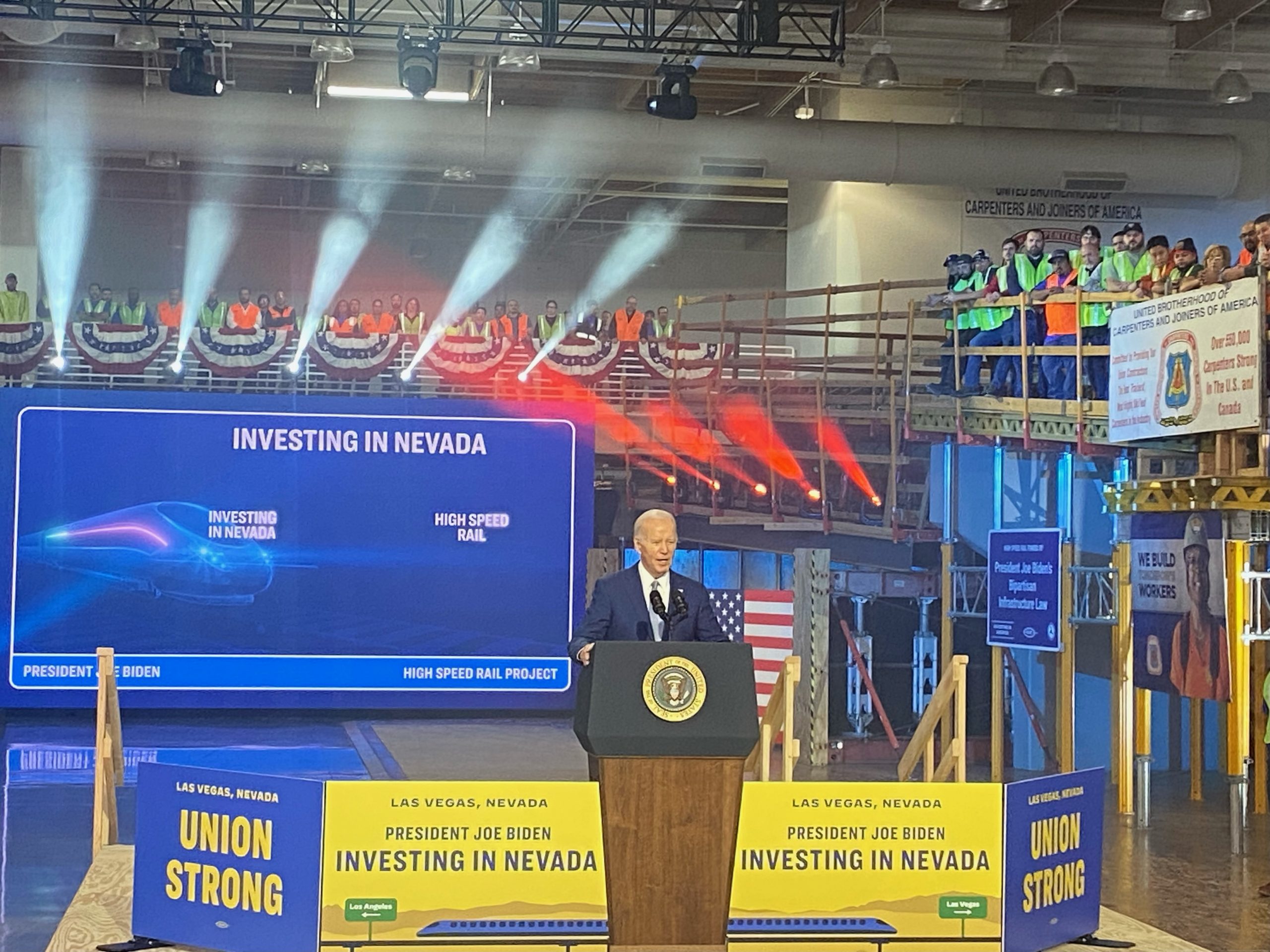
America’s First High-Speed Rail Project will Connect Las Vegas and Southern California
President Joe Biden joined elected officials from Nevada and California to formally announce that the Nevada Department of Transportation (NDOT) has received $3 billion in funding from the Federal-State Partnership for Intercity Passenger Rail Grant Program for Brightline West. Brightline West will connect Las Vegas and Southern California and will be the nation’s first true high-speed rail system. The project will also be the first to be built with American union labor. The fully-electric, zero-emission system will become one of the greenest forms of transportation in the U.S.
President Biden was joined by Nevada officials including Governor Joe Lombardo, Senators Jacky Rosen and Catherine Cortez Masto, Representatives Dina Titus, Susie Lee and Steven Horsford. Also in attendance were representatives from the High Speed Rail Labor Coalition and the Nevada Building Trades.
Brightline West’s modern, eco-friendly system will redefine train travel in America and connect two of the most iconic destinations: Las Vegas and Southern California. This 218-mile passenger rail service will reach speeds up to 200 mph with no grade crossings and the alignment is within the median of the I-15 highway. The system will feature three full-service stations in Las Vegas, Victor Valley and Rancho Cucamonga, Calif.
The Las Vegas station will include mobility connections and easy access to the Las Vegas Strip, the Raiders’ Allegiant Stadium and the Las Vegas Convention Center. The flagship Las Vegas station will be on 110 acres at the south end of Las Vegas Blvd. Brightline West’s California stations will include Victor Valley and Rancho Cucamonga, with direct connectivity via California Metrolink to key points in Los Angeles, such as Union Station.
Brightline West’s $12 billion project will bring widespread benefits including more than $10 billion in economic impact to Nevada and California. Economic studies show the project will create more than 35,000 (direct and indirect) jobs including 10,000 direct union construction jobs and nearly 1,000 permanent jobs for operations and maintenance. Brightline West’s investment also includes more than $800 million in roadway improvements to the I-15 corridor. Brightline West has agreements in place with several unions for the use of highly skilled union labor in critical jobs required to build, operate and maintain the project.
The project’s environmental benefits are equally impressive and designed to support Nevada and California’s climate strategies by promoting a no-emission mobility option that lowers greenhouse gasses by more than 400,000 tons of CO2 each year. The diversion of people from auto and air travel to Brightline West’s high-speed rail system reduces vehicle miles traveled by more than 700 million each year and 16,000 short haul flights annually.
The $3 billion grant award marks the largest in NDOT’s history and is the culmination of more than two decades of planning and coordination to build a high-speed rail line between Las Vegas and Southern California. NDOT, as the grant administrator, will continue to play an important oversight role as Brightline West constructs the rail system. Additionally, NDOT will be responsible for the design, construction, and oversight of any NDOT infrastructure that requires modification as a result of Brightline West’s work.
Transportation
Inland Empire Regional Chamber of Commerce Event to Spotlight Brightline West
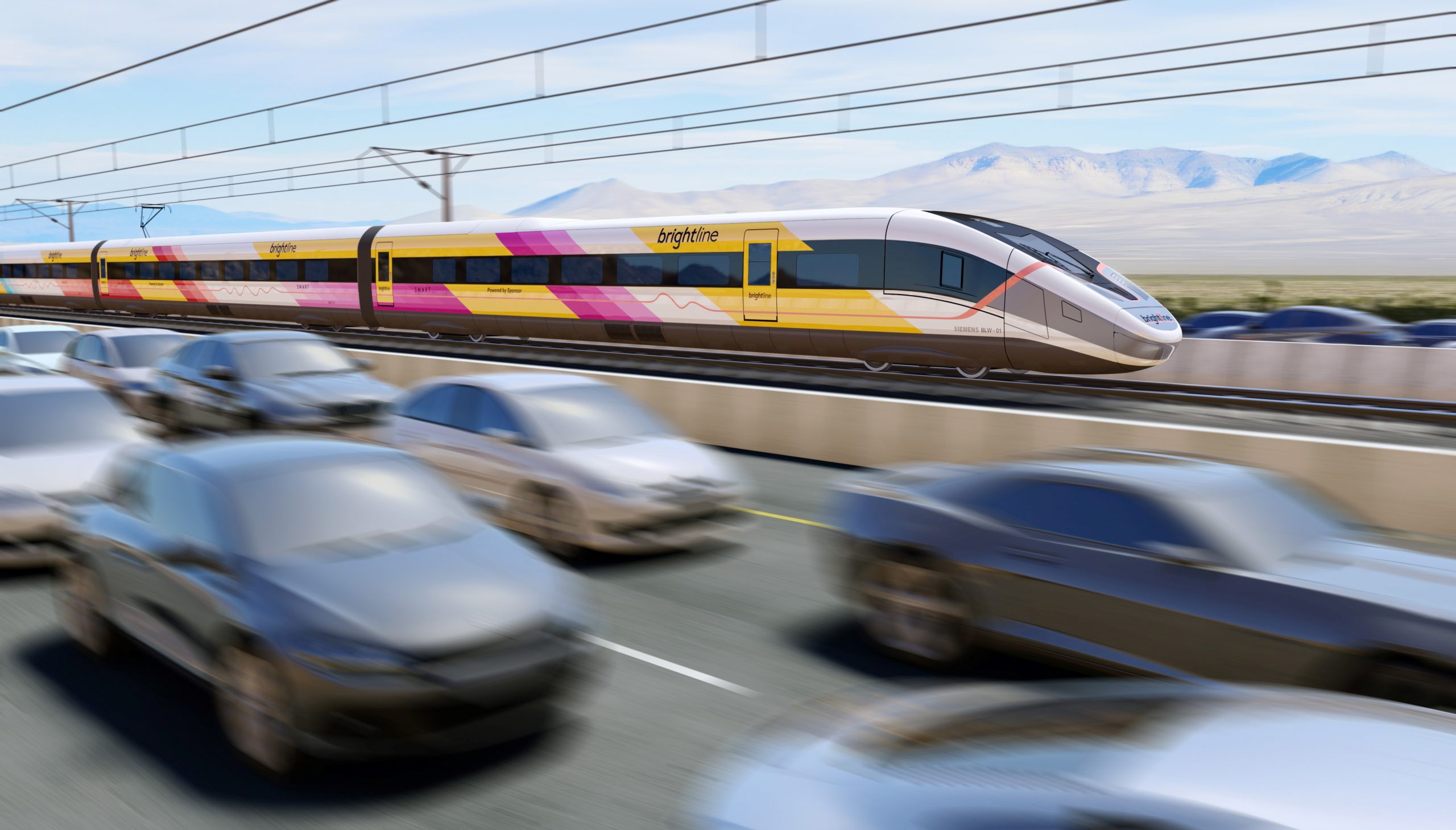
Program will highlight what’s next for high-speed rail in the Inland Empire
High-Impact Event Alert
Brightline West will be featured during the Inland Empire Regional Chamber of Commerce’s “High-Speed Rail is Headed to the Inland Empire” event on Wednesday, January 11, from 11:00 a.m. – 1:30 p.m. at Jessie Turner Community Center in Fontana, CA, which the County of San Bernardino is a title sponsor. The program will feature an update on Brightline West, including the project’s role in regional and statewide connectivity, its benefits to the community, what to expect in 2023, and how the public can stay engaged.
Featured panelists for the program are:
- Fiona Ma, Treasurer, State of California
- Ray Wolfe, Executive Director, San Bernardino County Transportation Authority
- Sarah Watterson, President, Brightline West
- Edward Ornelas, Jr., President/CEO, Inland Empire Regional Chamber of Commerce
- Matt Burris, Deputy City Manager of Community Development, City of Rancho Cucamonga
Brightline is the only private provider of modern, eco-friendly, intercity passenger rail service in America. The company currently serves Miami, Aventura, Fort Lauderdale, Boca Raton, and West Palm Beach in Florida, with its Orlando station beginning service in 2023. Recognized by Fast Company as one of the Most Innovative Companies in travel, Brightline offers a guest-first experience designed to reinvent train travel and take cars off the road by connecting city pairs and congested corridors that are too close to fly and too long to drive. Brightline West will build on this award-winning service by connecting Las Vegas and Southern California, with stations in Las Vegas, Victor Valley, Hesperia, and Rancho Cucamonga, and connectivity to Metrolink’s regional rail network.
“This will transform transportation in Southern California and Las Vegas for generations by providing a fast and efficient connection that gets people out of their cars, reduces traffic congestion and decreases air pollution.” -Fiona Ma, California State Treasurer
KEY FACTS:
- Expected travel time is approx. 2 ¼ hours
- Our route is 2x faster than driving
- Zero-emission, electric train sets
- Expected top speed is 180 mph
- 400,000 tons of CO2 removed annually by reducing 3 million vehicles
- Connections to Metrolink and planned future connection to California High-Speed Rail in Palmdale
- Convenient station location on the Vegas strip (I-15)
For more information and to register for the event, click here.
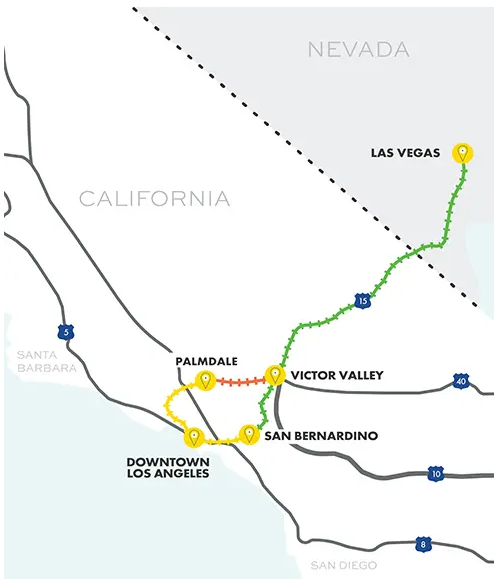
-

 Opinion1 year ago
Opinion1 year agoOntario International Airport Welcomes Avelo Airlines with New Nonstop Service to Sonoma County
-

 Philanthropy & Nonprofits1 year ago
Philanthropy & Nonprofits1 year agoUnited Way Unveils New Brand Strategy to Reflect Its Transformative Approach Forward
-

 Commercial Real Estate11 months ago
Commercial Real Estate11 months agoThe Evolution of Retail: A Comprehensive Look at the Inland Empire’s Newest Shopping Center
-

 Business8 months ago
Business8 months agoStrengthening Community Connections: Our Exciting New Partnership with Toyota Arena, Ontario Convention Center, and GOCAL
-

 Commercial Real Estate8 months ago
Commercial Real Estate8 months agoDedeaux Properties Completes Strategic Expansion with 850,000 Square Feet of New Industrial Developments Across Southern California
-

 Travel & Tourism9 months ago
Travel & Tourism9 months agoOntario International Airport to welcome STARLUX as its newest airline partner in June 2025


